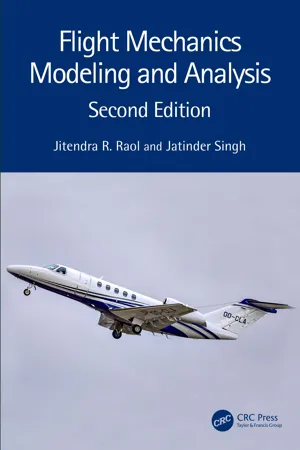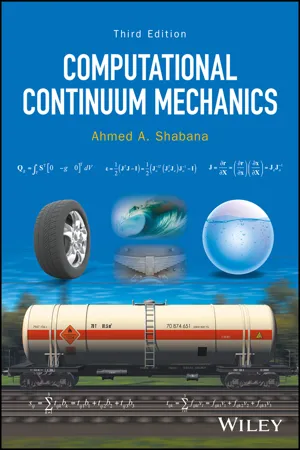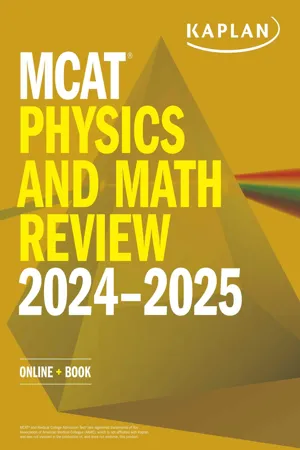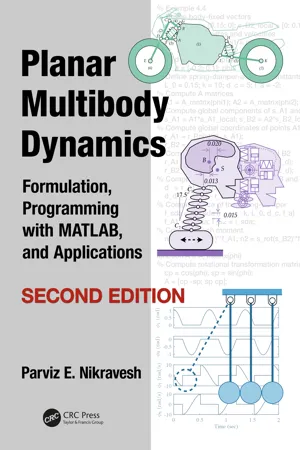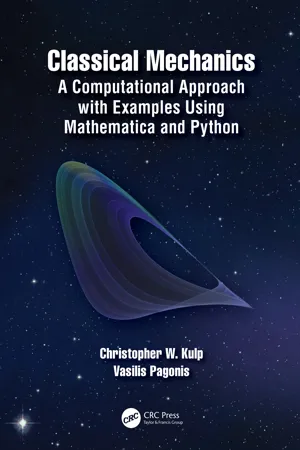Physics
Kinematic Equations
Kinematic equations are a set of equations that describe the motion of objects without considering the forces causing the motion. They are used to calculate various parameters such as displacement, velocity, and acceleration of an object in motion. These equations are derived from the basic principles of motion and are fundamental in solving problems related to motion in physics.
Written by Perlego with AI-assistance
Related key terms
7 Key excerpts on "Kinematic Equations"
- eBook - ePub
- Jitendra R. Raol, Jatinder Singh(Authors)
- 2023(Publication Date)
- CRC Press(Publisher)
3 ]. The chapter ends with a simplified explanation of the physics behind the working of gyroscope.2.2 Kinematics
The kinematics is concerned with the static aspects of mechanics wherein the inherent cause of the motion is not taken into account.2.2.1 Rectangular Cartesian Coordinates
Rectangular Cartesian coordinates are associated with orthogonal xyz axes that are right-handed by convention. Such coordinates are generally used to define position, velocity, and force vectors. For instance, position vector can be defined in terms of its components x, y, and z. Figure 2.1 shows the components of the position vectorR →. Assuming that the components ofR →vary with time, the position vectorR →can be expressed asFIGURE 2.1 Rectangular Cartesian coordinates.(2.1)R →= x( t )i ^+ y( t )j ^+ z( t )k ^wherei ^,j ^, andk ^are unit vectors. It is easy to obtain the velocity vector by differentiating (2.1) for position vector.(2.2)V →= u( t )i ^+ v( t )j ^+ w( t )k ^Further differentiation of the equation forV →shall provide the acceleration(2.3)a →=a x( t )i ^+a yj ^+a zk ^Here,u =,x ˙v =,y ˙w =; andz ˙,a x=x ¨,a y=y ¨a z=z ¨ - David V. Guerra(Author)
- 2023(Publication Date)
- CRC Press(Publisher)
7 Kinematics
DOI: 10.1201/9781003308065-77.1 Introduction
Thus far in this volume, the motion of the objects analyzed was simply at rest or in the case of the magnetic force, moving at a constant speed at one instant of time. The techniques applied to analyze a situation were centered around the analysis of vectors. A diagram was produced, vector components were found, an expression was applied, and solutions were found.At this point in the volume, the topic of kinematics, which is the terminology and the analysis employed to study the motion of objects, is introduced. The solutions to the problems in this chapter are associated with the definitions of different types of motion and not focused on the components of force vectors. Therefore, the pattern of analysis established in the previous chapters is not applied in this chapter, but it will return in the next chapter after the terminology and techniques of kinematics are studied.- Chapter question: A family makes an 800 km trip, strictly eastward, as described in Figure 7.1 . The family travels the first half of the trip distance at 80 km/h, quickly speeds up, and then maintains a speed of 100 km/h for the second half of the trip distance. For this entire trip, is the average speed 90 km/h? This question will be answered at the end of the chapter using the formal mathematical study of motion, called Kinematics, which is the topic of this chapter.
FIGURE 7.1 Family trip.
7.2 Kinematic Definitions
Kinematics, first developed by Galileo, is the formal study of the motion of objects using diagrams, graphs, and equations. In the previous chapters, the analysis employed assumed the objects were either at rest or moving at a constant speed. Situations under these conditions are known as a static, because the forces are balanced. When the forces become unbalanced, accelerated motion results. In this chapter, the terminology used to describe all types of motion is formalized in preparation for subsequent chapters in which the resulting motion of unbalanced force will be studied. This chapter will start with a definition of displacement and then explore velocity and acceleration in both graphical and analytical formats. It is important to realize that the problem-solving techniques employed in this chapter are different than those used in the previous and subsequent chapters, and this is only a brief aside to introduce the terminology and practices of kinematics.- eBook - ePub
- Hiqmet Kamberaj(Author)
- 2021(Publication Date)
- De Gruyter(Publisher)
4 Two- and three-dimensional motionIn this chapter, we will discuss the kinematics of a particle moving in two and three dimensions. Utilizing two- and three-dimensional motion, we will be able to examine a variety of movements, starting with the motion of satellites in orbit to the flow of electrons in a uniform electric field. We will begin studying in more detail the vector nature of displacement, velocity, and acceleration. Similar to one-dimensional motion, we will also derive the Kinematic Equations for three-dimensional motion from these three quantities’ fundamental definitions. Then the projectile motion and uniform circular motion will be described in detail as particular cases of the movements in two dimensions.4.1 The displacement, velocity, and acceleration vectors
When we discussed the one-dimensional motion (see Chapter 3 ), we mentioned that the movement of an object along a straight line is thoroughly described in terms of its position as a function of time,x ( t ). For the two-dimensional motion, we will extend this idea to the movement in thex yplane.As a start, we describe a particle’s position by the position vector r pointing from the origin of some coordinate system to the particle located in thex yplane, as shown in Fig. 4.1 . At timet ithe particle is at point P, and at some later timet fit is at the position Q. The path from P to Q generally is not a straight line. As the particle moves from P to Q in the time intervalΔ t =, its position vector changes fromt f−t ir itor f.Definition 4.1 (Displacement vector).
The displacement is a vector, and the displacement of the particle is the difference between its final position and its initial position. We now formally define the displacement vector for the particle as the difference between its final position vector and its initial position vector:(4.1)Δ r =r f−r i.The direction ofΔ ris indicated in Fig. 4.1 from P to Q. Note that the magnitude ofΔ r - eBook - ePub
- Ahmed A. Shabana(Author)
- 2018(Publication Date)
- Wiley(Publisher)
CHAPTER 2 KINEMATICSIn this chapter, the general Kinematic Equations for the continuum are developed. The kinematic analysis presented in this chapter is purely geometric and does not involve any force analysis. The continuum is assumed to undergo an arbitrary displacement and no simplifying assumptions are made except when special cases are discussed. Recall that in the special case of an unconstrained three-dimensional rigid-body motion, six independent coordinates are required in order to describe arbitrary rigid-body translation and rotation displacements. The general displacement of an infinitesimal material volume on a deformable body, on the other hand, can be described in terms of 12 independent variables: 3 translation parameters, 3 rigid-body rotation parameters, and 6 deformation parameters. One can visualize these modes of displacements by considering an infinitesimal cube that may undergo an arbitrary displacement. The cube can be translated in three independent orthogonal directions (translation degrees of freedom), rotated as a rigid body about three orthogonal axes, and subjected to six independent modes of deformation. These deformation modes are elongations or contractions in three different directions and three shear deformation modes.It is shown in this chapter that the rotations and the deformations can be completely described using the matrix of the position vector gradients, which in general has nine independent elements. This fact can be mathematically proven using the polar decomposition theorem discussed in the preceding chapter. The deformation at the material points on the body can be described in terms of six independent strain components. These strain components can be defined in the undeformed reference configuration leading to the Green–Lagrange strains or can be defined using the current deformed configuration leading to the Eulerian or Almansi strains. The velocity gradients and the rate of deformation tensor - No longer available |Learn more
MCAT Physics and Math Review 2024-2025
Online + Book
- (Author)
- 2023(Publication Date)
- Kaplan Test Prep(Publisher)
CHAPTER 1KINEMATICS AND DYNAMICS
In This Chapter
Fundamental Measurements1.1 UnitsVector Addition Vector Subtraction Multiplying Vectors by Scalars Multiplying Vectors by Other Vectors1.2 Vectors and ScalarsDisplacement Velocity1.3 Displacement and VelocityForces Mass and Weight Acceleration1.4 Forces and AccelerationFirst Law Second Law Third Law1.5 Newton’s LawsLinear Motion Projectile Motion Inclined Planes Circular Motion1.6 Motion with Constant AccelerationFree Body Diagrams Translational Equilibrium Rotational Equilibrium1.7 Mechanical EquilibriumConcept SummaryCHAPTER PROFILE
The content in this chapter should be relevant to about 6% of all questions about physics on the MCAT. This chapter covers material from the following AAMC content category:4A: Translational motion, forces, work, energy, and equilibrium in living systemsIntroduction
A professor once said: Biology is chemistry. Chemistry is physics. Physics is life. Not surprisingly, this was the claim of a physics professor.Walking into MCAT preparation, many students think of physics as the least applicable science to medicine, reflecting on calculus-heavy premedical classes. But even in the medical field, physics is all around us. When we treat patients at a rehab hospital, we often talk about motion, forces, and bone strength. An ophthalmologist may draw diagrams to help students better understand myopia and hyperopia. When we talk about mitochondria functioning as the batteries of the cell, we mean that fairly literally.This first chapter reviews the three systems of units encountered on the MCAT: MKS (meter–kilogram–second), CGS (centimeter–gram–second), and SI (International System of Units). We’ll take a few moments to review the geometry of physics questions, especially vector mathematics. Next, we’ll move into true physics content as we consider kinematics—the equations that deal with the motion of objects—and Newtonian mechanics and dynamics—the study of forces and their effects. - eBook - ePub
Planar Multibody Dynamics
Formulation, Programming with MATLAB®, and Applications, Second Edition
- Parviz Nikravesh(Author)
- 2018(Publication Date)
- CRC Press(Publisher)
3Fundamentals of Planar Kinematics
This chapter presents a summary of some fundamental concepts of planar kinematics. We first review the kinematics of a single particle, and then we consider the fundamental formulas for the kinematics of a single planar rigid body. Definitions for arrays of coordinates, constraint equations, degrees of freedom, and kinematic joints are also discussed.The kinematic definitions and fundamental formulas for kinematics of particles and rigid bodies that are discussed in this chapter will be used extensively throughout this textbook. Therefore, it is important to understand these simple but fundamental formulas at this point. Exercises with MATLAB® are provided to carry out most of the computations, even though most of the examples are very simple and the calculations may be performed on paper. It is our intent to use MATLAB as much as possible and be prepared to solve more complex and realistic problems whenever needed.3.1 A Particle
The simplest body arising in the study of motion is a particle , or a point mass . Analysis of the behavior of a point mass can lead to the kinematic and dynamic analysis of a body, and eventually to the analysis of a system of bodies. Therefore, it is essential to study the kinematics of particles first. In this textbook, we use the terms particles and points interchangeably.3.1.1 Kinematics of a Particle
The most fundamental step in planar kinematics is to describe the position of a particle or a point in a plane. A plane is described by a nonmoving Cartesian reference frame x–y . The position of a typical particle A in the plane is described by vectoras shown in Figure 3.1 . The components of the position vectorr →A, or the x–y coordinates of particle Ar →A - eBook - ePub
Classical Mechanics
A Computational Approach with Examples Using Mathematica and Python
- Christopher W. Kulp, Vasilis Pagonis(Authors)
- 2020(Publication Date)
- CRC Press(Publisher)
CHAPTER 2Single-Particle Motion in One DimensionIn this chapter, we will examine one-dimensional motion, i.e., motion along a line. It is sometimes the case that a particle’s motion need only to be described along one direction. Furthermore, a careful study of one-dimensional motion will be a useful foundation for understanding more general motion in higher dimensions. In this chapter, we will give several examples of solving Newton’s second law, F = ma in one dimension. We will consider several types of forces: both constant and those which depend on time F(t), velocity F(v), and position F(x). In addition, we will discuss and demonstrate two different uses of computers to solve physics problems: how to use computer algebra systems (CAS) to obtain the analytical solutions of Newton’s second law, and how to obtain numerical solutions of ordinary differential equations (ODE) using software packages and by using the Euler method.2.1Equations of motionTo begin our study of one-dimesional motion, we first need to make some assumptions about the object whose motion we are examining. One fundamental assumption in this chapter is that the object being studied is a point particle. In order to mathematically describe the motion of a particle under the influence of a force, we need to find the particle’s equations of motion. The equations of motion of a particle are the equations which describe its position, velocity, and acceleration as a functions of time. Equations of motion can be in the form of algebraic equations, or in the form of differential equations.As we will see, the equations of motion of a particle can be found by solving Newton’s second law as a differential equation. In this chapter, we will focus on one-dimensional motion, where the force vector and the particle’s displacement are along the same line (but not necessarily in the same direction—the direction could be horizontal or vertical). Because all vectors in a given problem lay along the same line, we drop the vector notation in all the equations. A negative sign between two quantities will denote vectors that lay in opposite directions along the same line.
Index pages curate the most relevant extracts from our library of academic textbooks. They’ve been created using an in-house natural language model (NLM), each adding context and meaning to key research topics.
